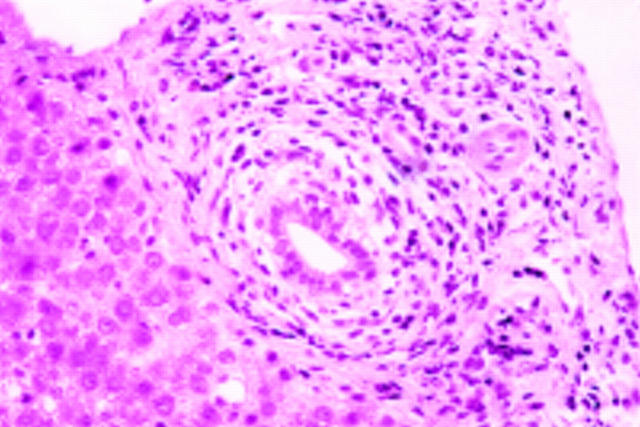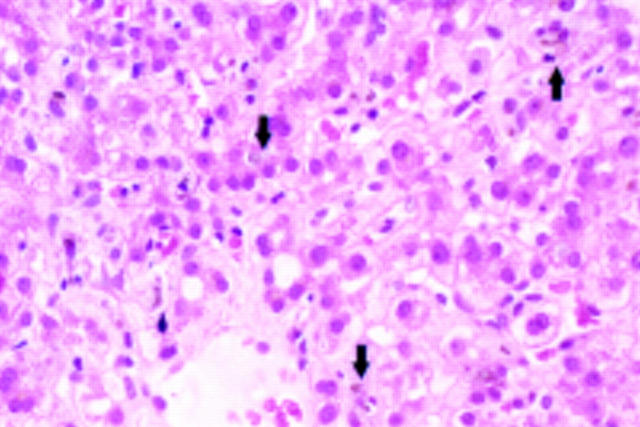Abstract
BACKGROUND AND AIMS—Jaundice associated with co-amoxiclav has been increasingly recognised. We aimed to characterise its clinical and histological features and to investigate linkage with human leucocyte antigen class II haplotypes. METHODS—We identified cases in the west of Scotland in the period 1991-1997 and performed polymerase chain reaction amplification and oligonucleotide probing on whole blood. RESULTS—Twenty two cases were identified (10 male, mean age 59.1 years). Jaundice occurred a median of 17 days after drug commencement, with a median peak bilirubin level of 225 µmol/l (range 84-598) and median duration of jaundice 69 days (range 29-150). Two patients had primary biliary cirrhosis and two other patients had persistently abnormal liver biochemistry on follow up. One death occurred in a frail elderly woman despite resolving jaundice. The frequency of jaundice was 1 in 78 209 co-amoxiclav prescriptions. Liver biopsy, available in 12 patients, showed perivenular bilirubinostasis, accompanying reactive ceroid laden macrophages, and portal inflammation with focal injury to interlobular bile ducts. Fourteen of 20 patients had DRB1*1501 compared with 27 of 134 controls (p<2.5×10-6; odds ratio (OR) 9.25; relative risk (RR) 6.43). Of these, seven patients were homozygous for DRB1*1501(p< 10-8; OR 35.54; RR=8.68) compared with two of 134 controls. All patients with DRB1*1501 had the extended haplotype DRB1*1501-DRB5*0101-DQA1*0102-DQB1*0602. There were no clinical or histological differences between genotypes. CONCLUSIONS—Co-amoxiclav associated hepatotoxicity may have a genetic basis and be delayed, severe, and prolonged, although complete recovery is usual. Keywords: co-amoxiclav; jaundice; human leucocyte antigen
Full Text
The Full Text of this article is available as a PDF (142.6 KB).
Figure 1 .
Portal tract containing a mainly lymphocytic inflammatory infiltrate. There is inflammation and oedema around the bile duct which contains intraepithelial lymphocytes and shows epithelial damage (haematoxylin and eosin).
Figure 2 .
Perivenular bilirubinostasis with intracellular and intracanalicular bile plugs (arrows) with cholestatic rosettes (haematoxylin and eosin).
Selected References
These references are in PubMed. This may not be the complete list of references from this article.
- Begovich A. B., Klitz W., Moonsamy P. V., Van de Water J., Peltz G., Gershwin M. E. Genes within the HLA class II region confer both predisposition and resistance to primary biliary cirrhosis. Tissue Antigens. 1994 Feb;43(2):71–77. doi: 10.1111/j.1399-0039.1994.tb02303.x. [DOI] [PubMed] [Google Scholar]
- Blumenthal M., Marcus-Bagley D., Awdeh Z., Johnson B., Yunis E. J., Alper C. A. HLA-DR2, [HLA-B7, SC31, DR2], and [HLA-B8, SC01, DR3] haplotypes distinguish subjects with asthma from those with rhinitis only in ragweed pollen allergy. J Immunol. 1992 Jan 15;148(2):411–416. [PubMed] [Google Scholar]
- Bénichou C. Criteria of drug-induced liver disorders. Report of an international consensus meeting. J Hepatol. 1990 Sep;11(2):272–276. doi: 10.1016/0168-8278(90)90124-a. [DOI] [PubMed] [Google Scholar]
- Cramp M. E., Carucci P., Underhill J., Naoumov N. V., Williams R., Donaldson P. T. Association between HLA class II genotype and spontaneous clearance of hepatitis C viraemia. J Hepatol. 1998 Aug;29(2):207–213. doi: 10.1016/s0168-8278(98)80005-6. [DOI] [PubMed] [Google Scholar]
- García Rodríguez L. A., Stricker B. H., Zimmerman H. J. Risk of acute liver injury associated with the combination of amoxicillin and clavulanic acid. Arch Intern Med. 1996 Jun 24;156(12):1327–1332. doi: 10.1001/archinte.1996.00440110099013. [DOI] [PubMed] [Google Scholar]
- García Rodríguez L. A., Stricker B. H., Zimmerman H. J. Risk of acute liver injury associated with the combination of amoxicillin and clavulanic acid. Arch Intern Med. 1996 Jun 24;156(12):1327–1332. doi: 10.1001/archinte.1996.00440110099013. [DOI] [PubMed] [Google Scholar]
- Hautekeete M. L., Brenard R., Horsmans Y., Henrion J., Verbist L., Derue G., Druez P., Omar M., Kockx M., Hubens H. Liver injury related to amoxycillin-clavulanic acid: interlobular bile-duct lesions and extrahepatic manifestations. J Hepatol. 1995 Jan;22(1):71–77. doi: 10.1016/0168-8278(95)80262-2. [DOI] [PubMed] [Google Scholar]
- Hautekeete M. L., Horsmans Y., Van Waeyenberge C., Demanet C., Henrion J., Verbist L., Brenard R., Sempoux C., Michielsen P. P., Yap P. S. HLA association of amoxicillin-clavulanate--induced hepatitis. Gastroenterology. 1999 Nov;117(5):1181–1186. doi: 10.1016/s0016-5085(99)70404-x. [DOI] [PubMed] [Google Scholar]
- Hebbard G. S., Smith K. G., Gibson P. R., Bhathal P. S. Augmentin-induced jaundice with a fatal outcome. Med J Aust. 1992 Feb 17;156(4):285–286. doi: 10.5694/j.1326-5377.1992.tb139752.x. [DOI] [PubMed] [Google Scholar]
- Horton H., Weston S. D., Hewitt C. R. Allergy to antibiotics: T-cell recognition of amoxicillin is HLA-DR restricted and does not require antigen processing. Allergy. 1998 Jan;53(1):83–88. doi: 10.1111/j.1398-9995.1998.tb03778.x. [DOI] [PubMed] [Google Scholar]
- Larrey D., Vial T., Micaleff A., Babany G., Morichau-Beauchant M., Michel H., Benhamou J. P. Hepatitis associated with amoxycillin-clavulanic acid combination report of 15 cases. Gut. 1992 Mar;33(3):368–371. doi: 10.1136/gut.33.3.368. [DOI] [PMC free article] [PubMed] [Google Scholar]
- Otsuka S., Yamamoto M., Kasuya S., Ohtomo H., Yamamoto Y., Yoshida T. O., Akaza T. HLA antigens in patients with unexplained hepatitis following halothane anesthesia. Acta Anaesthesiol Scand. 1985 Jul;29(5):497–501. doi: 10.1111/j.1399-6576.1985.tb02242.x. [DOI] [PubMed] [Google Scholar]
- Reddy K. R., Brillant P., Schiff E. R. Amoxicillin-clavulanate potassium-associated cholestasis. Gastroenterology. 1989 Apr;96(4):1135–1141. doi: 10.1016/0016-5085(89)91633-8. [DOI] [PubMed] [Google Scholar]
- Ryley N. G., Fleming K. A., Chapman R. W. Focal destructive cholangiopathy associated with amoxycillin/clavulanic acid (Augmentin). J Hepatol. 1995 Sep;23(3):278–282. [PubMed] [Google Scholar]
- Strettell M. D., Donaldson P. T., Thomson L. J., Santrach P. J., Moore S. B., Czaja A. J., Williams R. Allelic basis for HLA-encoded susceptibility to type 1 autoimmune hepatitis. Gastroenterology. 1997 Jun;112(6):2028–2035. doi: 10.1053/gast.1997.v112.pm9178696. [DOI] [PubMed] [Google Scholar]
- Stricker B. H., Blok A. P., Claas F. H., Van Parys G. E., Desmet V. J. Hepatic injury associated with the use of nitrofurans: a clinicopathological study of 52 reported cases. Hepatology. 1988 May-Jun;8(3):599–606. doi: 10.1002/hep.1840080327. [DOI] [PubMed] [Google Scholar]
- Svejgaard A., Ryder L. P. HLA and disease associations: detecting the strongest association. Tissue Antigens. 1994 Jan;43(1):18–27. doi: 10.1111/j.1399-0039.1994.tb02291.x. [DOI] [PubMed] [Google Scholar]
- Sweet J. M., Jones M. P. Intrahepatic cholestasis due to ticarcillin-clavulanate. Am J Gastroenterol. 1995 Apr;90(4):675–676. [PubMed] [Google Scholar]
- Yasoshima M., Nakanuma Y., Tsuneyama K., Van de Water J., Gershwin M. E. Immunohistochemical analysis of adhesion molecules in the micro-environment of portal tracts in relation to aberrant expression of PDC-E2 and HLA-DR on the bile ducts in primary biliary cirrhosis. J Pathol. 1995 Mar;175(3):319–325. doi: 10.1002/path.1711750310. [DOI] [PubMed] [Google Scholar]
- van den Broek J. W., Buennemeyer B. L., Stricker B. H. Cholestatische hepatitis door de combinatie amoxicilline en clavulaanzuur (Augmentin). Ned Tijdschr Geneeskd. 1988 Aug 6;132(32):1495–1497. [PubMed] [Google Scholar]




